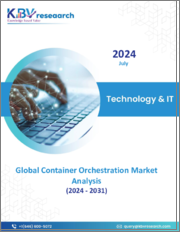
|
시장보고서
상품코드
1556167
세계의 컨테이너 오케스트레이션 시장 : 현황 분석 및 예측(2024-2032년)Container Orchestration Market: Current Analysis and Forecast (2024-2032) |
||||||
컨테이너 오케스트레이션 시장은 약 17%의 성장률을 보일 것으로 예상됩니다. 그 배경에는 클라우드 서비스 제공업체 및 기타 기술 기업과의 전략적 제휴를 통해 제품 제공 및 시장 도달 범위를 강화할 수 있기 때문입니다. 예를 들어, 2021년 5월 레드햇(International Business Machines)과 IBM Research는 Konveyor 프로젝트를 시작했습니다. 이 오픈소스 프로젝트는 오픈 하이브리드 클라우드를 위한 도구 구축, 패턴 식별, IT 전반에 클라우드 네이티브 혁신을 가져오는 방법에 대한 조언 제공을 통해 오픈 하이브리드 클라우드를 위한 용도의 현대화 및 전환을 지원하는 것을 목표로 합니다.
컴포넌트 기반으로 시장은 플랫폼과 서비스로 양분됩니다. 플랫폼 부문은 컨테이너화된 용도를 배포, 관리 및 확장하는 데 필요한 기반 인프라와 도구를 제공함으로써 컨테이너 오케스트레이션 시장에서 가장 큰 시장 점유율을 차지할 것으로 예상되며, AWS, Google Cloud 및 Azure와 같은 Kubernetes와 같은 매니지드 서비스를 통해 컨테이너 오케스트레이션의 복잡성을 줄이고 보다 빠르고 효율적인 개발 주기를 가능하게 하는 통합 오케스트레이션 서비스를 제공함으로써 컨테이너 오케스트레이션을 보다 쉽고 빠르게 구현할 수 있게 되었습니다. 보다 빠르고 효율적인 개발 주기를 가능하게 합니다. 이러한 광범위한 접근성과 기존 클라우드 에코시스템과의 통합으로 인해 기업들은 최신 용도 관리를 위한 확장 가능하고 탄력적이며 비용 효율적인 솔루션을 찾고 있으며, 이는 시장 성장에 박차를 가하고 있습니다.
조직 규모에 따라 시장은 대기업과 중소기업으로 나뉩니다. 이 중 대기업 부문이 가장 큰 시장 점유율을 차지할 것으로 예상됩니다. 이는 복잡하고 광범위한 IT 수요로 인해 대기업이 컨테이너 오케스트레이션 시장 성장에 중요한 역할을 할 것으로 예상되기 때문입니다. 이들 기업은 하이브리드 및 멀티 클라우드 환경 모두에 걸쳐 수백에서 수천 개의 용도를 운영하는 경우가 많으며, 운영의 일관성을 유지할 수 있는 도구가 필요합니다. 컨테이너 오케스트레이션 플랫폼은 유연성과 자동 확장성을 제공하여 대기업이 워크로드, 활용도 및 용도 보증을 관리하는 데 매우 적합합니다. 이러한 솔루션을 통해 대기업은 디지털 전환 전략을 추진하고, 비즈니스 복잡성을 줄이고, 컨테이너화된 용도의 신속한 배포 및 관리를 통해 시장 경쟁력을 유지할 수 있습니다.
시장은 업종별로 IT/통신, 은행/금융서비스/보험(BFSI), 정부/공공 부문, 헬스케어, 소매/소비재, 제조, 기타로 구분됩니다. 이 중 IT 및 통신이 가장 큰 시장 점유율을 차지할 것으로 예상됩니다. 마이크로서비스 아키텍처와 클라우드 네이티브 용도는 소프트웨어 업계에서 널리 받아들여지고 있으며, 컨테이너 오케스트레이션은 컨테이너 프로비저닝, 확장 및 관리를 중앙 집중화 및 자동화할 수 있는 수단을 제공합니다. 이러한 요구는 5G 기술, 엣지 컴퓨팅, IoT의 채택이 지속적으로 증가함에 따라 서비스 수요자의 역동적인 워크로드에 대응하기 위해 더욱 증가하고 있습니다. 이에 따라 IT 및 통신 분야에서는 더욱 복잡하고 다양한 최신 IT 인프라에 필수적인 향상된 컨테이너 오케스트레이션 기능과 정교한 애플리케이션 딜리버리에 대한 요구가 높아지고 있습니다.
컨테이너 오케스트레이션 시장 도입에 대한 이해를 돕기 위해 북미(미국, 캐나다, 기타 북미), 유럽(독일, 영국, 프랑스, 스페인, 이탈리아, 기타 유럽), 아시아태평양(중국, 일본, 인도, 기타 아시아태평양), 기타 지역 세계 시장 현황을 기반으로 시장을 분석했습니다.의 세계 입지를 기준으로 분석되었습니다. 이 중 아시아태평양은 예측 기간 동안 가장 빠른 CAGR로 성장할 것으로 예상됩니다. 이는 클라우드 채택, 디지털 혁신, 마이크로서비스 아키텍처와 같은 새로운 임베디드 시스템 도입에 기인합니다. 컨테이너 오케스트레이션의 주요 국가로는 중국, 인도, 일본, 한국 등이 있으며, 이들 국가는 확장성, 유연성, 용도 배포 효율성을 높이기 위해 쿠버네티스와 같은 툴을 사용하고 있습니다. 또한, 소프트웨어 개발 및 배포를 관리하기 위한 일련의 관행인 데브옵스(DevOps)에 대한 요구가 증가하면서 시장 성장에 힘을 실어주고 있습니다. 또한, 이 지역의 신생 기술 기업 및 IT 대기업들은 보다 진보된 IT 인프라와 혁신을 위해 컨테이너 오케스트레이션을 도입할 가능성이 높습니다.
시장에 진출한 주요 기업으로는 Acquia Inc., Amazon Web Services Inc, Juniper Networks, Inc., Giant Swarm GmbH, IBM 등이 있습니다.
목차
제1장 시장 서론
- 시장의 정의
- 주요 목적
- 이해관계자
- 제한 사항
제2장 조사 방법 또는 전제조건
- 조사 과정
- 조사 방법
- 응답자 개요
제3장 주요 요약
- 업계 요약
- 부문별 전망
- 시장 성장 강도
- 지역 전망
제4장 시장 역학
- 성장 촉진요인
- 기회
- 성장 억제요인
- 동향
- PESTEL 분석
- 수요측 분석
- 공급측 분석
- 인수합병(M&A)
- 투자 시나리오
- 업계 인사이트 : 대형 스타트업 기업과 독자적인 전략
제5장 가격 분석
- 지역별 가격 분석
- 가격에 영향을 미치는 요인
제6장 세계의 컨테이너 오케스트레이션 시장 매출, 2022-2032년
제7장 시장 분석 : 컴포넌트별
- 플랫폼
- 서비스
제8장 시장 분석 : 조직 규모별
- 대기업
- 중소기업
제9장 시장 분석 : 업종별
- 통신 및 IT
- 은행/금융서비스/보험(BFSI)
- 정부 및 공공 부문
- 헬스케어
- 소매 및 소비재
- 제조
- 기타
제10장 시장 분석 : 지역별
- 북미
- 미국
- 캐나다
- 기타 북미
- 유럽
- 독일
- 영국
- 프랑스
- 이탈리아
- 스페인
- 기타 유럽
- 아시아태평양
- 중국
- 일본
- 인도
- 기타 아시아태평양
- 세계 기타 지역
제11장 밸류체인 분석
- 한계분석
- 시장 진출기업 리스트
제12장 경쟁 구도
- 경쟁 대시보드
- 경쟁 시장 포지셔닝 분석
- Porter의 Five Forces 분석
제13장 기업 개요
- Acquia Inc.
- Amazon Web Services Inc.
- AppDynamics
- DigitalOcean, LLC.
- Mendix Technology
- Google LLC
- Intel Corporation
- Juniper Networks, Inc.
- Giant Swarm GmbH
- IBM
제14장 두자어와 전제조건
제15장 부록
LSH 24.10.10The container orchestration market is rapidly growing due to the increasing trends of organizations choosing applications based on containers to improve scalability and flexibility in software development. Platform containers, a new class of software applications, offer automated solutions for managing, deploying, scaling, and networking containers, which are user-friendly for businesses with intricate applications in cloud, on-premises, and hybrid domains. The market is fueled by consideration of the growth of cloud-native apps, the increase in the use of microservices architecture, and the paradigm of continuous integration/continuous delivery (CI/CD). This means that while enterprises are increasing attention toward company digitalization, the container orchestration market will also experience continuous growth in the future.
The container orchestration market is set to exhibit a growth rate of about 17%. This is due to strategic alliances with cloud service providers and other tech firms that can enhance product offerings and market reach. For instance, in May 2021, Red Hat Inc. (International Business Machines Corporation) and IBM Research launched the Konveyor Project. An open-source project aimed at helping modernize and migrate applications for the open hybrid cloud by building tools, identifying patterns, and providing advice on how to bring cloud-native transformation across IT.
Based on components, the market is bifurcated into platforms and services. The platform category is expected to have the largest market share of the container orchestration market by providing the foundational infrastructure and tools necessary for deploying, managing, and scaling containerized applications. Cloud platforms like AWS, Google Cloud, and Azure offer integrated orchestration services, making it easier for enterprises to adopt and implement these technologies. The availability of managed services, such as Kubernetes, reduces the complexity of container orchestration, enabling faster and more efficient development cycles. This broad accessibility and integration with existing cloud ecosystems accelerate adoption, fueling market growth as businesses seek scalable, resilient, and cost-effective solutions for modern application management.
Based on the organization size, the market is bifurcated into Large Enterprises and SMEs. Among these, the large enterprises category is expected to have the largest market share of the market. This is due to complex and extensive IT demand; large enterprises are expected to play a crucial role in boosting the growth of the Container Orchestration market. These organizations often operate hundreds or even thousands of applications spread across both hybrid and multi-cloud environments, which need tools to maintain operations cohesiveness. Container orchestration platforms offer flexibility and auto scalability which are very applicable for large enterprises to manage their workloads, utilization, and assurance of their apps. With these solutions, large enterprises can advance their digital transformation strategies, decrease business intricacies, and ensure their company sustains market competitiveness through the speedy deployment and management of containerized applications.
Based on the vertical, the market is segmented into Telecommunications & IT, BFSI, Government & Public Sector, Healthcare, Retail & Consumer Goods, Manufacturing, and Others. Among these, the Telecommunications & IT category is expected to have the largest market share of the market. Due to the microservices architectures and cloud-native applications gaining wide acceptance in the software industry, container orchestration provides a centralized and automated means of provisioning, scaling, and managing the containers. This need is exacerbated by the continuously rising adoption of 5G technology, edge computing, and the IoT, as they respond to dynamic workloads depending on whoever is requesting their services. For this reason, the Telecommunications & IT sector strongly drives the need for enhanced container orchestration capabilities and fine-tuned application delivery, essential in more complex and diverse modern IT infrastructures.
For a better understanding of the market adoption of container orchestration, the market is analyzed based on its worldwide presence in countries such as North America (U.S., Canada, and the Rest of North America), Europe (Germany, U.K., France, Spain, Italy, Rest of Europe), Asia-Pacific (China, Japan, India, Rest of Asia-Pacific), Rest of World. Among these, the Asia Pacific region will grow at the fastest CAGR during the forecast period. This is due to cloud adoption, digital reforms, and a new incorporative system such as microservices architecture. Some of the leading countries in container orchestration are China, India, Japan, and South Korea, which are using tools like Kubernetes for better scalability, flexibility, and efficiency in application deployment. The market is also fuelled by the increasing need for DevOps, which is a set of practices aimed at the management of software development and deployment. Moreover, the rising technology start-ups and IT large-scale enterprises across the region are also likely to implement container orchestration for better advanced IT infrastructure and innovation.
Some of the major players operating in the market include Acquia Inc., Amazon Web Services Inc., AppDynamics, DigitalOcean, LLC., Mendix Technology, Google LLC, Intel Corporation, Juniper Networks, Inc., Giant Swarm GmbH, and IBM.
TABLE OF CONTENTS
1.MARKET INTRODUCTION
- 1.1. Market Definitions
- 1.2. Main Objective
- 1.3. Stakeholders
- 1.4. Limitation
2.RESEARCH METHODOLOGY OR ASSUMPTION
- 2.1. Research Process of the Global Container Orchestration Market
- 2.2. Research Methodology of the Global Container Orchestration Market
- 2.3. Respondent Profile
3.EXECUTIVE SUMMARY
- 3.1. Industry Synopsis
- 3.2. Segmental Outlook
- 3.2.1. Market Growth Intensity
- 3.3. Regional Outlook
4.MARKET DYNAMICS
- 4.1. Drivers
- 4.2. Opportunity
- 4.3. Restraints
- 4.4. Trends
- 4.5. PESTEL Analysis
- 4.6. Demand Side Analysis
- 4.7. Supply Side Analysis
- 4.7.1. Merger & Acquisition
- 4.7.2. Investment Scenario
- 4.7.3. Industry Insights: Leading Startups and Their Unique Strategies
5.PRICING ANALYSIS
- 5.1. Regional Pricing Analysis
- 5.2. Price Influencing Factors
6.GLOBAL CONTAINER ORCHESTRATION MARKET REVENUE (USD MN), 2022-2032F
7.MARKET INSIGHTS BY COMPONENT
- 7.1. Platform
- 7.2. Services
8.MARKET INSIGHTS BY ORGANISATION SIZE
- 8.1. Large Enterprises
- 8.2. SMEs
9.MARKET INSIGHTS BY VERTICAL
- 9.1. Telecommunications & IT
- 9.2. BFSI
- 9.3. Government & Public Sector
- 9.4. Healthcare
- 9.5. Retail & Consumer Goods
- 9.6. Manufacturing
- 9.7. Others
10.MARKET INSIGHTS BY REGION
- 10.1. North America
- 10.1.1. U.S.
- 10.1.2. Canada
- 10.1.3. Rest of North America
- 10.2. Europe
- 10.2.1. Germany
- 10.2.2. U.K.
- 10.2.3. France
- 10.2.4. Italy
- 10.2.5. Spain
- 10.2.6. Rest of Europe
- 10.3. Asia-Pacific
- 10.3.1. China
- 10.3.2. Japan
- 10.3.3. India
- 10.3.4. Rest of Asia-Pacific
- 10.4. Rest of World
11.VALUE CHAIN ANALYSIS
- 11.1. Marginal Analysis
- 11.2. List of Market Participants
12.COMPETITIVE LANDSCAPE
- 12.1. Competition Dashboard
- 12.2. Competitor Market Positioning Analysis
- 12.3. Porter Five Forces Analysis
13.COMPANY PROFILED
- 13.1. Acquia Inc.
- 13.1.1. Company Overview
- 13.1.2. Key Financials
- 13.1.3. SWOT Analysis
- 13.1.4. Product Portfolio
- 13.1.5. Recent Developments
- 13.2. Amazon Web Services Inc.
- 13.3. AppDynamics
- 13.4. DigitalOcean, LLC.
- 13.5. Mendix Technology
- 13.6. Google LLC
- 13.7. Intel Corporation
- 13.8. Juniper Networks, Inc.
- 13.9. Giant Swarm GmbH
- 13.10. IBM















